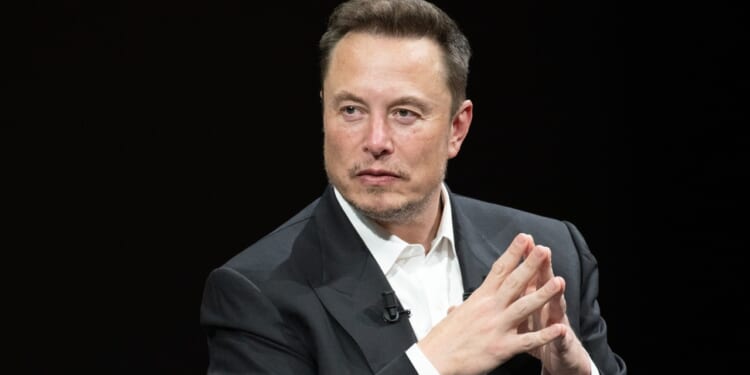Orbital data centers could be one solution to the difficulty of building large projects in the United States, amid restrictive laws and often local opposition.
After suffering ostracization from his erstwhile political ally, President Donald Trump, Elon Musk has rededicated himself and his private space company, SpaceX, to dominating the private space sector. And he’s not just keeping himself focused on only reusable rockets and getting a mission to Mars.
Musk is always innovating, thinking toward the future—and in particular how to acquire funding to support his ultimate ambition of getting people to Mars and colonizing the Red Planet.
Enter Musk’s contribution to the artificial intelligence revolution (which is ultimately about far more than just artificial intelligence). For the revolution to succeed, AI research requires massive amounts of infrastructure—namely vast tracts of land for server farms, large quantities of water for cooling those server farms, and energy.
Already, there has been pushback across the United States about converting land into server farms to support AI. The principle of NIMBY (Not In My Backyard)—local residents opposing resource-draining megaprojects in their communities—is at play here. So Musk has stepped in with a unique solution: orbital datacenters.
Orbital Data Centers Could Power the AI Revolution
According to the iconoclast tech guru, by simply scaling up SpaceX’s upcoming Starlink V3 satellites (which will reportedly possess significantly higher data throughput/laser links), these satellites could become orbital datacenters to contribute much-needed computing power for the burgeoning AI revolution.
This comes on the heels of another, new innovative set of firms that are focusing exclusively on building datacenters in orbit. Rendezvous Robotics has partnered with Starcloud to build self-assembling orbital datacenters. Musk senses a pristine opportunity to grow SpaceX even more while competing with new startups that are trying to carve out a unique niche in the overall space and AI sectors.
By placing datacenters in orbit, the tech firms can skirt some of the issues facing proposed datacenters in the United States. Positioning datacenters in orbit rather than on Earth offloads high-power computational tasks and could, theoretically, reduce terrestrial energy use and the environmental footprint (though some of that environmental impact would undoubtedly be worsened by the launch of these systems into orbit).
Further, enabling computing closer to certain data sources (such as satellites, probes, as well as eventual lunar and Martian infrastructure) would allow for greater dissemination of data where transmitting raw data back to Earth is inefficient. It also creates a new market in orbital infrastructure—not just satellites, but placing a “cloud in space.” More importantly, in the age of new great power competition for dominance in the tech sector, placing datacenters in orbit adds a layer of resilience. Distributed computation is less vulnerable to Earth-based disruption and vice-versa.
Starlink V3 will support around one terabit per second data transmission speeds (10 times the current 100 Gbps), and that scaling could be the backbone of orbital datacenters. SpaceX’s existing satellite constellation gives them a platform and network already in space. Moving into an orbital computational role, such as placing datacenters under SpaceX’s control in orbit, is but a logical extension of these moves.
Musk Still Hasn’t Worked Out All the Problems Yet
As with any major undertaking—especially a technically complex task like placing datacenters in orbit—there will be complications and setbacks. But that’s okay. So long as we are furthering the technology and learning that’s really all that one can ask.
And we cannot give up if things get tough.
In orbit, you don’t have the same convective air-cooling environment as you have on Earth. Radiative cooling is possible, but constructing huge radiators, managing waste heat, and keeping electronics at safe temperatures are all non-trivial complicating factors to this most ambitious project.
Plus, a large datacenter requires enormous amounts of power. These systems would rely on solar power, but they will need additional infrastructure—solar arrays, power conversion, storage, and redundancy—as well as having the ability to manage transmission of power and heat.
Building and maintaining this complex infrastructure would be expensive compared to the equivalent on Earth. While satellites already transmit data, placing large compute workloads in orbit raises questions about latency, connectivity to Earth, data backhaul, and user access. And if anything goes wrong, sending a technician out to fix it would be anything but trivial.
Still, this is an exciting prospect—and is indicative of a great country seeking to do big things in an innovative industry that could easily revolutionize the world. Working through these problems is an opportunity for innovation rather than a hindrance. While Western business practices favor short-termism, this mentality needs to be jettisoned out the nearest airlock if we expect to be truly innovative.
Musk has the right idea. He and other space barons should absolutely try their hand at developing orbital datacenters.
About the Author: Brandon J. Weichert
Brandon J. Weichert is a senior national security editor at The National Interest. Recently, Weichert became the host of The National Security Hour on America Outloud News and iHeartRadio, where he discusses national security policy every Wednesday at 8pm Eastern. He is also a contributor at Popular Mechanics and has consulted regularly with various government institutions and private organizations on geopolitical issues. Weichert’s writings have appeared in multiple publications, including The Washington Times, National Review, The American Spectator, MSN, and the Asia Times. His books include Winning Space: How America Remains a Superpower, Biohacked: China’s Race to Control Life, and The Shadow War: Iran’s Quest for Supremacy. His newest book, A Disaster of Our Own Making: How the West Lost Ukraine is available for purchase wherever books are sold. He can be followed via Twitter @WeTheBrandon.
Image: Shutterstock / Frederic Legrand – COMEO.


















